Beauty from brokenness: How Our Savior Lutheran’s windows reflect the hope of Christmas
On our first Christmas in Lake Worth, in 1965, my mother was 33, pregnant and grieving.
Her husband — my father, Don, the handsome TV anchor and news director at Honolulu’s CBS station, KGMB — had died of a heart attack one month before.
Just like that, Helen Tuckwood’s glamorous life in a five-star hotel overlooking Waikiki Beach with her talented 36-year-old husband and two blond little girls came to a full stop.
More holiday eventsBest ongoing Christmas events in Palm Beach County
More to see and do:Don't miss out on these best top outdoor events in Palm Beach County for 2022-23
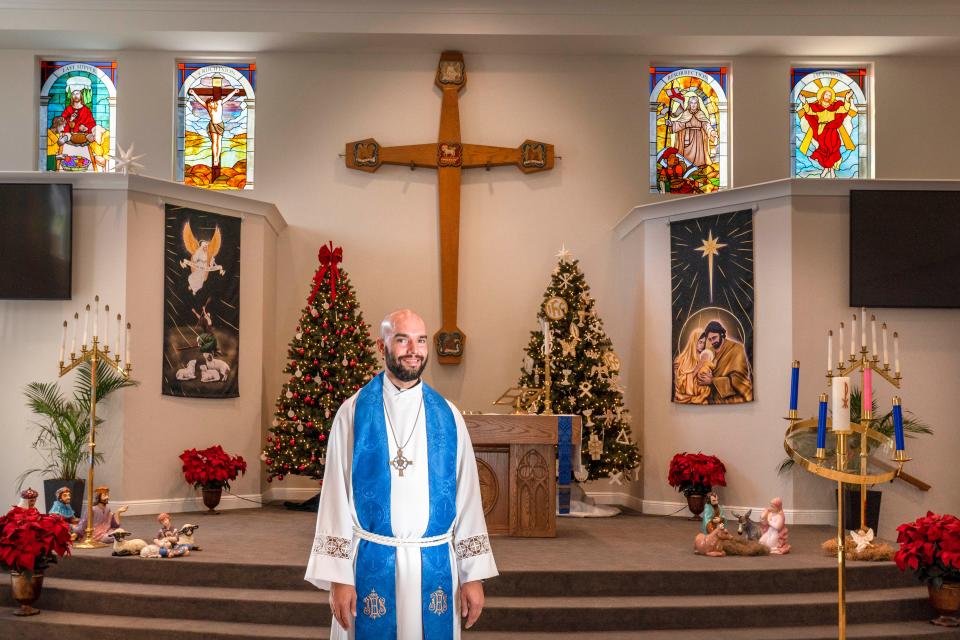
We moved to Lake Worth and crammed into her parents’ two-bedroom, one-bath house on Federal Highway. My mother found solace in her faith and in her church: Our Savior Lutheran Church, on the corner of Lake Avenue and A Street.
She was expecting a baby in April, and she hoped for a son.
That Christmas, I got a Barbie, the one with the bubble haircut. I remember nothing else except my gut-wrenching heartbreak. I was 9, old enough to know too much.
My mother rarely cried in front of my 5-year-old sister, Lynn, and me. But she would sit in those church pews at Our Savior every Sunday, and she would pray: “God, I know you are a father to the fatherless. Help me. Help me, God.”
As she prayed, I’d watch rays of light filter into the modern, A-frame sanctuary through the huge, art-glass windows. The chunky blocks of colored glass, with chips or “oysters” on the edges to reflect light, were arranged to form abstract designs and held together with resin.
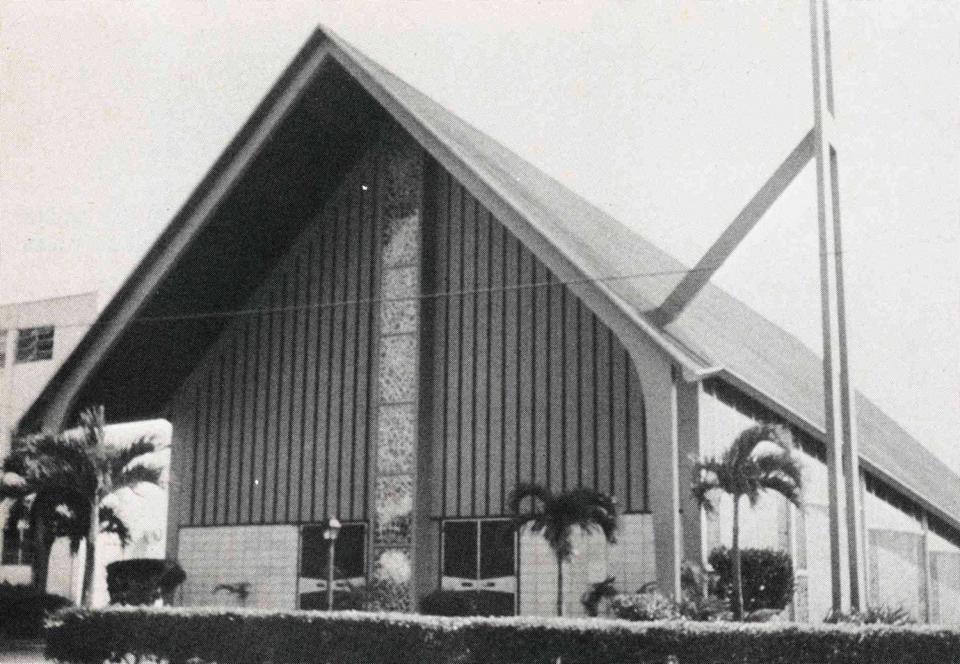
These colorful windows — crafted in a style called “dalle de verre,” French for “slab of glass” — were all the rage in churches built in the 1960s.
Like the streamlined architecture of the wood A-frame sanctuary, the windows made a statement: this church and its people are hip, happening and now.
That church was so cool; it was designed to look like a fish, the symbol of Jesus, if you gazed down at it from the air.
The new Our Savior was the stylistic opposite of the first church built by parishioners decades before. That quaint church, a traditional stucco design with traditional leaded stained-glass windows, still stands at Lake Avenue and B Street.
The new Our Savior was designed by dreamers, by Lutherans who thought big and believed Lake Worth would keep growing.
They couldn’t imagine a day when their congregation would have fewer than 2,000 members or when Our Savior Lutheran School, the three-story school they built just to the south of the church, would not be thriving. My mother taught second grade at the school for 20 years.
She would explain to us what the church’s windows meant — how the chunks of jewel-toned glass told the story of the Bible, from creation through the crucifixion and resurrection of Jesus to the Pentecost when flames danced on the disciples' heads.
The windows had to be explained because you couldn’t really tell what you were looking at; but it was cool in the 1960s, like the new “guitar worship services” and bushy-haired youth ministers.
All that colored light seemed to bounce around like a kaleidoscope.
A church brochure explained: “The medium of our windows is glass and epoxy, a new process for making art-glass windows which is more durable than the well-known process of setting glass into lead.”
The young me, whose life had been turned upside down, was pretty sure “new” wasn’t always better.
In 2005, 40 years after I showed up, that A-frame church got turned upside down, too.
Wilma’s unholy wrath on Our Savior Lutheran Church
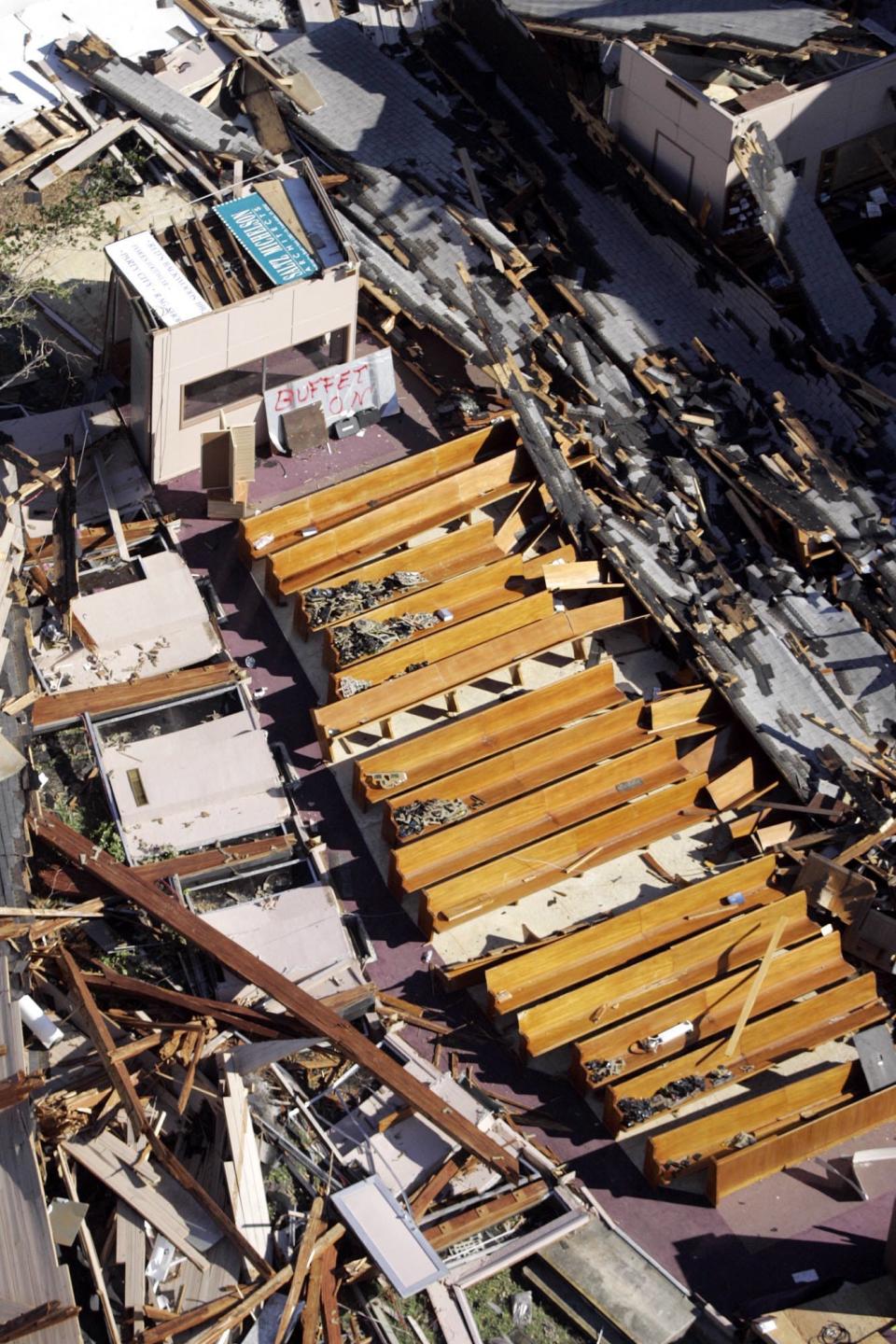
Hurricane Wilma flattened Our Savior Lutheran Church on Oct. 24, 2005.
The monument to modern worship collapsed like a house of cards — or, in this case, a house of shards.
In aerial photos after the Category 3 hurricane hit, the sanctuary looked like an open-face splinter sandwich in the vague shape of a fish.
Those fancy “dalle de verre” windows were not made to last. In fact, the resin was so thin in some places, and the glass chunks had been chipped so much in some places, that the only thing separating the sanctuary from the storm was a fraction of an inch.
All it took was a tiny hole between the glass and the resin, and the thermodynamics of hurricane-force winds doomed the church.
The wind pushed in, then up — and the wood arches came tumbling down.
Shanon Materio of McMow Art Glass in Lake Worth has been making stained-glass windows for 45 years.
“Dalle de verre” windows are such a specialty, she explained, that only two manufacturers in the world make the 1-inch-thick blocks of glass. The thickness of the glass gives it a bright color, and the chips hammered into the glass bring unrivaled illumination.
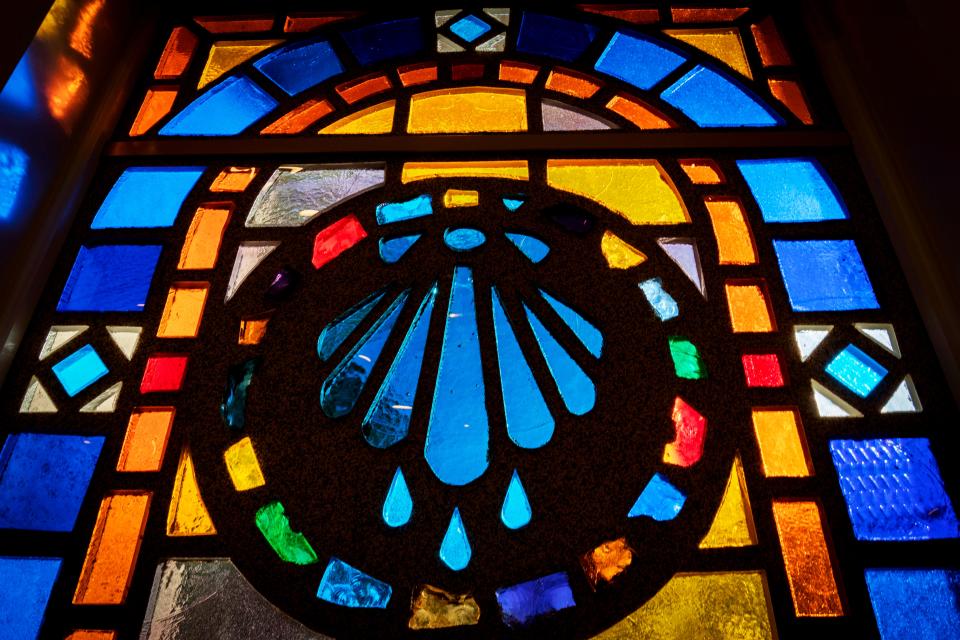
But the science must equal the art.
To maintain structural integrity, the resin must be as thick as the glass, she said, and it must be set perfectly, so the glass and resin expand and contract as one.
At Our Savior, the science did not equal the art.
“The expensive part of this isn’t the glass, it’s the resin,” she said. “Some studios didn’t use enough resin … they poured it too thin. These windows were probably compromised already for more than a couple of years.”
Plus, there were no support beams between the windows. “They were stacked on top of each other, with a little silicone between, and they were the only barrier between the weather and the interior of the building.”
Incredibly, this was not the first time a storm had blown down the wood beams of the sanctuary.
A booklet documenting the church’s history tells it like this:
“Work was progressing well with the erection of the 50-foot-high arches of the church when, on Sunday morning, Oct. 19, 1959, at the close of the 11 o’clock service in the chapel, Hurricane Judith toppled the arches.”
Hurricane Judith was a Category 1 storm that weakened to 50 mph winds when it made landfall around Boca Grande on Florida’s west coast on Oct. 18. By the time it crossed Florida and hit Palm Beach County, Judith was much weaker — but still strong enough to knock down the eight arches holding up the sanctuary.
The congregation had hoped to dedicate their new church by Christmas 1959, but they had to rebuild the wood-frame arches, then add the art-glass windows. The structure was built back and the cornerstone laid on Jan. 31, 1960. Dedication day: April 3, 1960.
That was fast construction — but not as fast as Hurricane Wilma’s destruction.
Wilma’s path was similar to Judith’s: it made landfall on Florida’s west coast and barreled east; but it was powerful, exiting near Jupiter with winds of 105 mph.
Parishioners couldn’t believe their eyes when they saw that their church was gone.
They sobbed and got down on their hands and knees to collect handfuls of colored glass.
So many memories: baptisms, confirmations, weddings, funerals. So much love.
The only things left intact were the 15-foot wood cross, the baptism font, the grand piano — and the many, many chunks of glass.
The glass was eventually gathered in bins and separated by color. They wanted to use it again, to build again.
For the next 16 years, Our Savior’s congregation worshiped in the school’s gymnasium. The school didn’t need it. It closed a few years after the hurricane.
And then, finally, in 2021, the gym space was renovated into a whole new sanctuary — not fancy, not hip, but as solid and safe as a bear hug.
It’s surrounded by a chain-link fence.
Beauty in the broken places
Our Savior Lutheran Church is different now than it was when I grew up, but after I look past the fence, I find it even more beautiful.
A young pastor, the Rev. Jake Roedsens, 39, arrived in June 2018. Everyone calls him “Pastor Jake.”
He tends a flock of about 250 members, and he makes a point of saying the church’s mission “is always about we, not me.” And always about Jesus.
“Jesus is active in all that we are doing all the time,” Pastor Jake says. He’s talking by phone from his truck, as he drives to South Bay to deliver Christmas gifts purchased by Our Savior members.
South Bay is the westernmost city in Palm Beach County and tiny, at 5,000 residents, about one-tenth the size of Lake Worth Beach, as Lake Worth is now called. Both cities are 33% white. Lake Worth Beach is now 44% Hispanic and nearly 19% African American.
“We listen to the community and their needs — instead of telling the community what they need,” Pastor Jake said.
And, so, Our Savior Lutheran Church remains what the community needs.
The Guatemalan Maya Center rents the first floor of the former school building, and the City Blessing Church leases the second floor. A Haitian Baptist church, Eglise Baptiste Des Rachetes, rents the old chapel. A Spanish congregation, Ministerios Casa de Oración, rents another school space. The Alzheimer’s Community Care center helps seniors in the parish-hall space across from the new sanctuary. A karate park for young people rents space here. A food pantry is here, too, and so is a free thrift store.
“The church is not one group of people, it’s many people,” Pastor Jake says. “Eternity is going to be filled with every tribe and every race and every color.”
Inside the new Our Savior Lutheran sanctuary, many colors shine, too — starting with the new stained-glass windows.
McMow Art Glass designed and made the 14 windows: four on the north wall showing Old Testament scenes and 10 more on the south and west walls showing the life of Jesus. Ten of the 14 have been installed.
“The new stained-glass windows are designed in the traditional methods of hand-cut, hand-painted and fired art glass,” says Bailey Nelson of McMow. Each one of McMow’s 11 master artists took part in making the windows, which require 100 hours or more to create.
Also installed: two “dalle de verre” windows: one commemorating baptism and the other communion.
“And the best part of the story,” Materio says, “is that we used glass from the old windows in those.”
Lifelong church members Rock and Lyn Tate sponsored the first window to get the excitement going. They chose the “Ascension” window, showing Jesus rising in glory from the dead — which now shines above the altar.
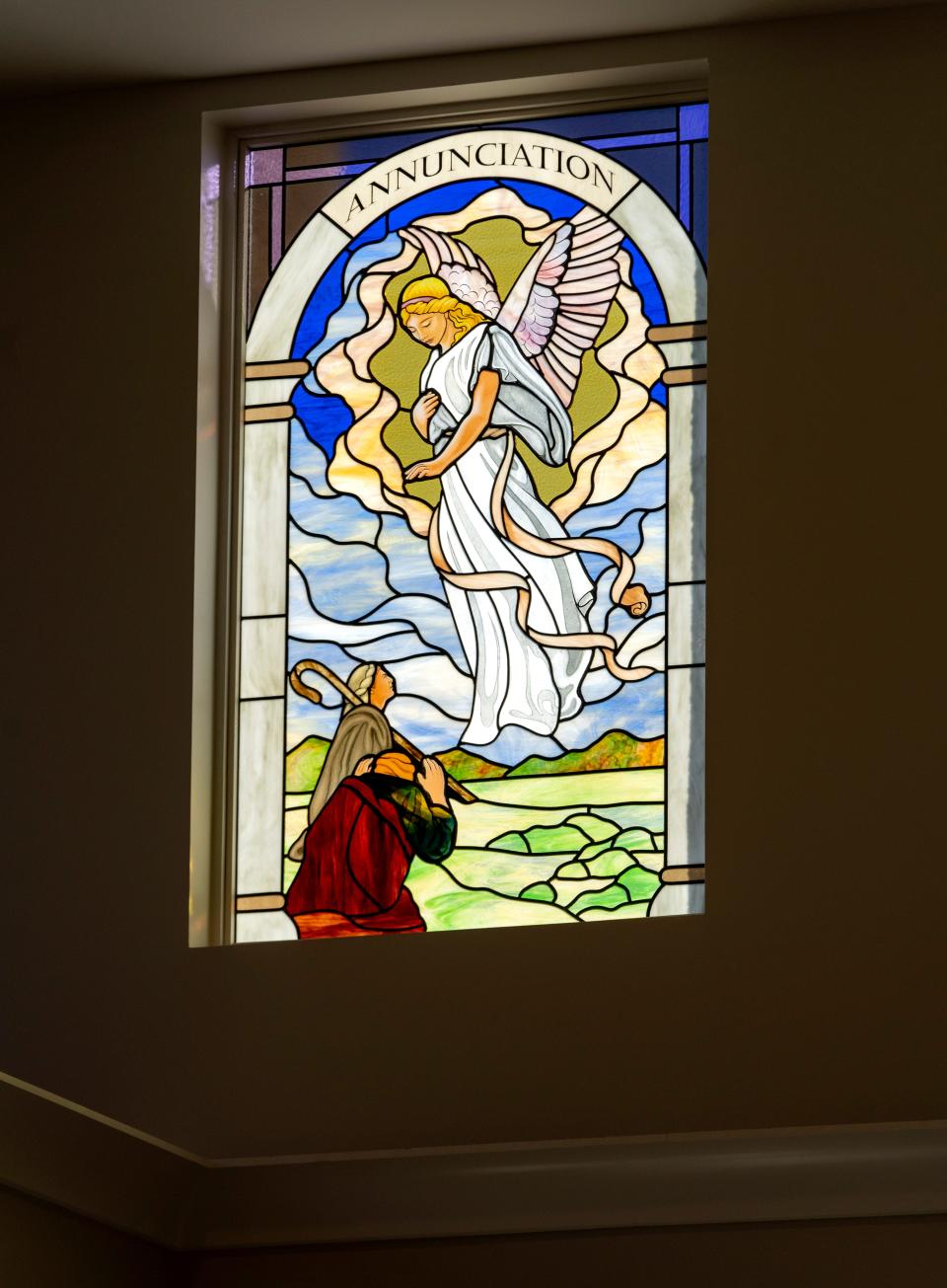
My sister, Lynn, and my brother, Don, and I purchased the “Annunciation” window in honor of our mother, who died March 26, 2021.
That window shows the angel Gabriel appearing to Mary, telling her she would bear the son of God.
“Fear not, Mary, for thou hast found grace with God,” Gabriel tells her. “Behold thou shalt conceive in thy womb, and shalt bring forth a son; and thou shalt call his name Jesus.”
Mary cowers, overwhelmed by the sight. “Help me, God,” she must have been thinking.
“Help me, God.” I can still hear my mother whispering those words.
The message of Jesus is as clear as the light shining through the glass: Feed the hungry, comfort the sick, heal the broken, love thy neighbor as thyself.
And believe in the meaning of Christmas: His light pours in … and gives us the strength to go on.
This article originally appeared on Palm Beach Post: Lake Worth Beach's Our Savior Lutheran Church restored from hurricane

